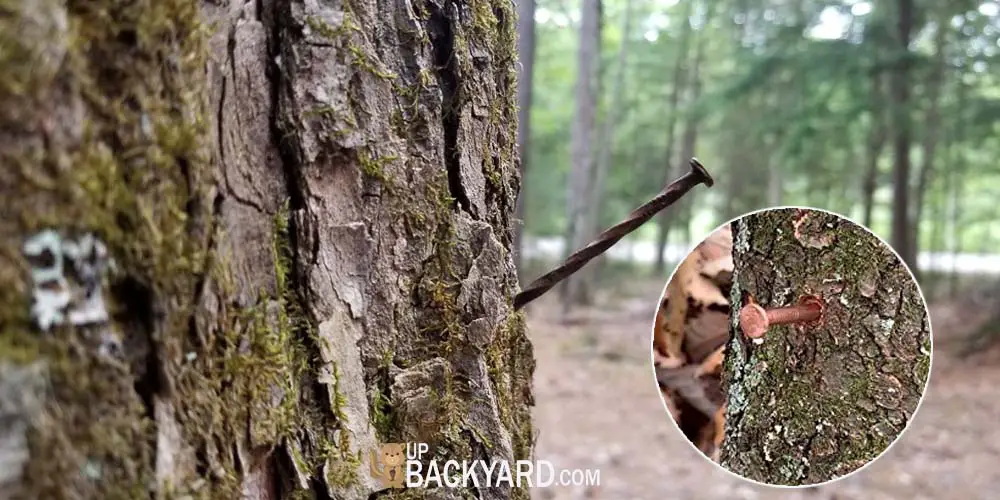Trees are one of the essential parts of our natural landscape where life has taken refuge for a long time. Humans are now using these trees by building roads, buildings, and other infrastructure. Trees are also a natural habitat for many species.
Their barks are typically rigid and thick and protect the inner tissues against damage. But sometimes, human activities can destroy them gradually.
Copper nails are one good example. Up to now, most people have been using copper nails to hang their Christmas lights. This is a problem because these nails are killing trees everywhere.
What Are Copper Nails?
These are nails made from copper alloys. Copper nails are often used when constructing houses and buildings because of their corrosion resistance. However, they have the disadvantage of causing significant damage to trees.
Why Does Copper Nail Kill Trees?
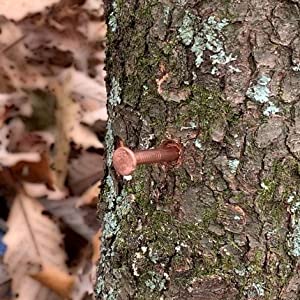
Measured amounts of copper are beneficial to trees and other plants. The element is, in fact, necessary for different metabolic activities of plants.
A slight addition to the required amount may go unnoticed because trees and plants, in general, are tolerant of low copper concentrations. However, unregulated amounts of it will cause damage in the following ways.
Oxidation of Copper
As we know it, the copper element doesn’t rust because, in its pure state, it contains zero iron, which is the main element for rust, iron oxide.
However, under certain conditions, it will get oxidized and turn into oxides of copper. Humid conditions tend to favor the oxidation process. These conditions are present in the limbs of trees and stems. If you drive nails into trees, they will undoubtedly get oxidized, leaving their surfaces tarnished.
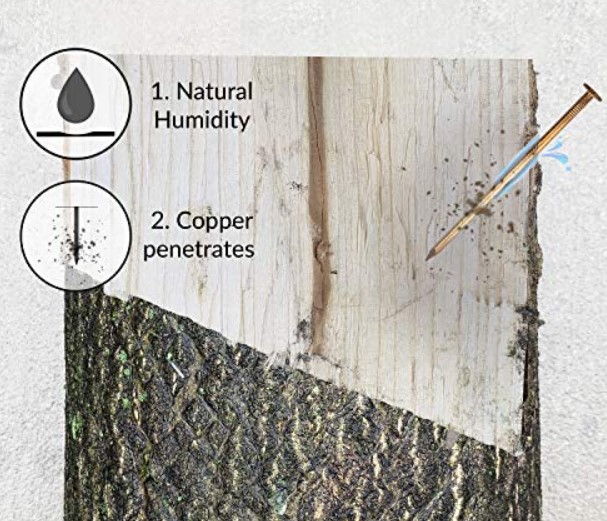
Tree stems and limbs are a kind of organic compound that cannot eliminate copper oxide properly, so it causes poisoning to the inner tissues of the tree, killing them slowly.
Copper Stunts The Functions of Growth Cells
The growth cells which help the limbs of trees grow are vital. The presence of copper in the stems and branches of the tree will stunt these cells’ development, leading to their inability to perform their primary function.
Copper Damages The Transport System of Trees
Copper is especially harmful when transported through the tree’s vascular system. Copper oxide in the stems of trees can trigger harm to the tree tissues that transport nutrients and water.
The result is that the area surrounding these tissues gets stunted, leading to a decline in the overall health and weight of the tree.
Severe Injury To The Most Important Transition Cell
Copper tends to form oxides that are harmful to transition cells. The result is that they die off and become detached from their surroundings. This causes the entire tree to be compromised and eventually die.
Copper Interferes With Nitrogen-Forming Organisms
The presence of copper in tree stems interferes with the development of nitrogen-forming organisms, which are also essential for the tree’s health and growth. It leads to stunting of trees and deformation of their overall shapes.
Copper Causes Damage To Roots
Copper and its oxides tend to damage root cuticles. These are the epidermal layers responsible for protecting trees against pests and other pathogens.
In cases where root cuticle has been damaged by copper, parasitic and pest organisms tend to be attracted to the trees, causing severe damage to their health.
Copper is also known to inhibit the growth of root hairs which are agents of absorption of water and nutrients. Reduced absorption of nutrients leads to stunting and eventually the death of trees.
Copper Causes Damage To Leaves
Copper can tarnish the leaves of trees. When it is in contact with them, it will cause spotting and wilting. The spots will, after some time, turn dark green and eventually do away with the chlorophyll in the leaves.
As we know from our elementary science, chlorophyll is responsible for photosynthesis, which is also responsible for making food for the tree. Lack of chlorophyll means the inevitable death of the tree.
In situations where total loss of chlorophyll doesn’t occur, spotting and wielding will prevent leaves from absorbing sunlight, causing their overall growth to slow down.
It is worth mentioning that regulated amounts of copper are essential for all photosynthesis processes. Still, when not regulated, it acts as the agent of destruction for what it helped build, quite the irony there.
How Long Does It Take For Copper Nails To Kill a Tree?
This is a good question and one that doesn’t have an exact answer because every tree has a different susceptibility to copper.
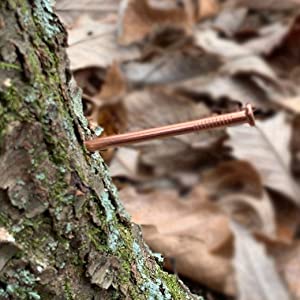
The tree’s health, location, amount of copper transported through its vascular system, and other factors are all determinants of how long it takes for copper nails to kill a tree.
Generally, it will take years for the real damage to be seen because slow degeneration means that the tree will have time to adapt to and recuperate from the harmful effects of copper.
Why Is It So Important To Protect Trees?
Tree Health is the most critical factor for the aesthetic value it can add to our environment and the air purification aspect. Trees are also nature’s way of ensuring we are healthy and protected against harsh conditions.
Trees are where oxygen is produced through a process known as photosynthesis, which produces ATP, giving us the energy to function normally.
In addition to this, trees are a significant source of food and other helpful elements such as paper.
This proves why it’s so important to take care of them.
How Can We Avoid The Negative Effects of Copper Nails on Trees?
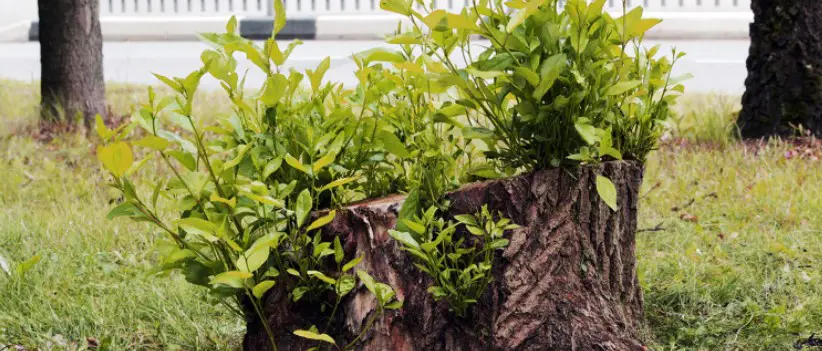
Make Sure That Your Nails Do Not Contain Copper Ore
We need nails for construction to be possible. However, they don’t have to be copper nails. In fact, they should not contain any copper ore.
There are always alternatives in the form of iron nails, which are equally strong if not stronger. Even though they might be susceptible to corrosion, they are cheaper than copper nails.
The characteristics of both nails are perfectly balanced, which makes them perfect substitutes.
If you have any copper nails, use them on dry wood and furniture rather than growing trees.
Use The Right Nail Size
If you have to use copper nails, use the correct size and not too big or too small. Too small nails will not get the job done. On the other hand, large nails will find their way into the tree’s anatomy.
The effects of copper on trees can, at times, be beneficial. You may have a trump in your backyard that never stops growing no matter what you do. In this situation, copper nails would kill the trump after some time.
To kill the trumps, you will need to drive in copper nails at an angle on the stem just above the ground. Drive as many nails as possible while maintaining a one-inch gap between them and forming a ring-like shape. The more copper nails you drive in, the faster the growth rate would decrease and eventually stop.
How To Remove Copper Nails From Trees?
Now that we know the effects of copper nails on trees, we need to learn how to protect them. We can remove copper nails from trees in several ways:
Use a Hammer

To get rid of them, we only need a hammer. A flat-head hammer should be enough for the job. It all depends on the size of the nail and how deep it is driven.
To do this, you will have to hold the hammer just below the head. This way, you will get more momentum with your swing and make sure nothing goes wrong.
Use a Crowbar
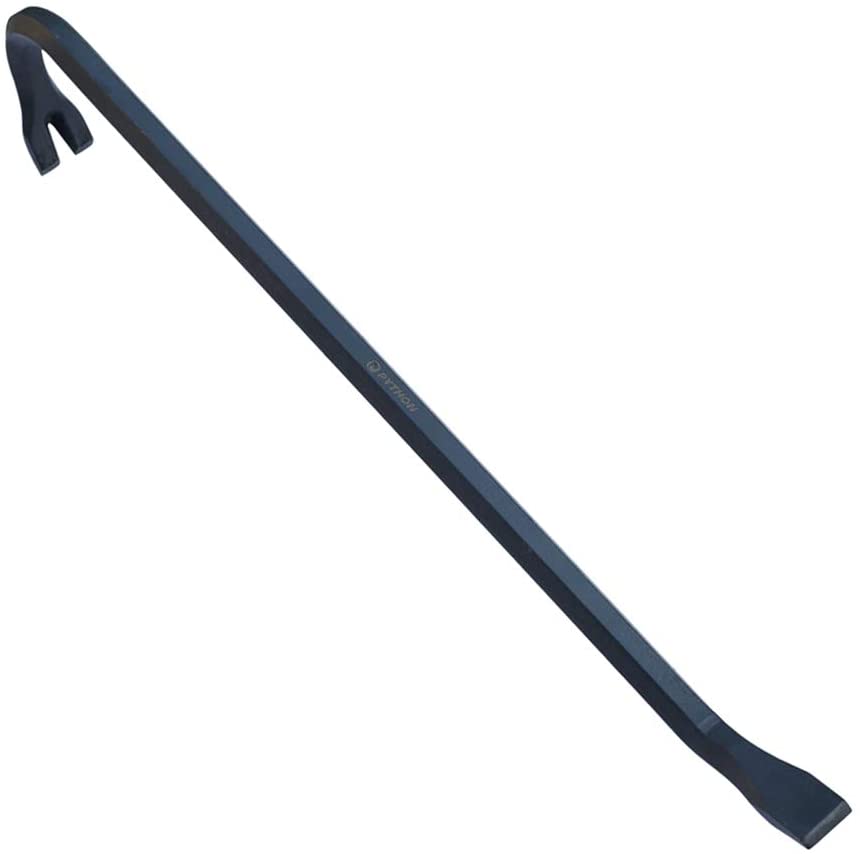
In cases where the nails are far deep in the wood and firmly held by the stem’s tissues, it will be challenging to get rid of them with a hammer alone. This is why you need a crowbar.
Use the claw end of your bar to pry nails out of the wood.
Remove the Nails With Your Hands
You may be away from the house or just in your backyard but without access to a hammer or a crowbar. If you find yourself in this situation, do not fret, there is a way to remove nails from trees by hand.
You need to bend the nail and keep pushing it in opposite directions to loosen it. At first, it will be firm, but you can use the help of a stone or another solid object. This will loosen up the nail, and you can now pull it out using your fingers.
Just make sure that the nail doesn’t come off with your skin because it can cause bleeding or damage to your fingers.
Break The Nails
If the wood is hard and you cannot get the nails out by hand, you can use a chisel or hammer to break them. This reduces their size and, consequently, reduces the amount of copper concentration.
